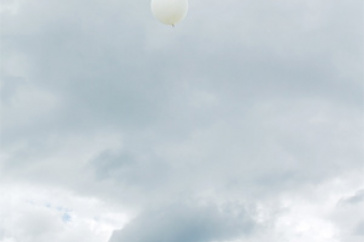High Schoolers Launch Unique Balloon Experiment During UNH Summer Institute

The reentry vehicle attached to the weather balloon lifts off in Plymouth
DURHAM, N.H. - A handful of high school students made history of a sort recently when the one-of-a-kind reentry vehicle they built out of pink Styrofoam and corrugated cardboard fell back to Earth without aid of a parachute following a 15-minute balloon ride up to 100,000 feet - the edge of outer space. Unfortunately, the experimental vehicle got caught in a 120-mile-per-hour jet stream and landed 90 miles from the Plymouth launch site in the ocean near the Isles of Shoals off of Portsmouth.
The dish-shaped reentry vehicle - one meter in diameter and weighing under two kilograms, the Federal Aviation Administration limit - carried a payload of a miniscule Geiger counter, two temperature sensors, and two video cameras about the size of a pack of gum. During the flight the students obtained real-time measurements of changing levels of cosmic rays and atmospheric temperatures. The video images, had the cameras not ended up in the drink, would have shown the balloon bursting (under pressure) at 100,000 feet, the curvature of the Earth, and the blackness of outer space.
The experiment was part of their four-week Project SMART (Science and Mathematics Achievement through Research Training) summer residential program at the University of New Hampshire, which concluded last week. The program, now in its 20th year, is designed to help spur upper-class high school students into careers in science and mathematics. Students work with faculty in three disciplinary modules - space science, marine and environmental science, and bio- and nanotechnology.
Says Subhash Minocha, director of Project SMART and UNH professor of plant biology and genetics, "The summer institute provided the opportunity for 44 students to learn the interdisciplinary nature of the various scientific fields and how math and computers converge with scientific research. Students also study and discuss the applications and implications - economic, social, environmental, legal, ethical and moral - of scientific advancements to society."
Minocha adds that student diversity and broad representation has become a major goal of his over the past three years and, as a result, this summer's crop "was one of the most diverse ever in terms of geographic, ethnic, racial, and economic backgrounds, thanks to financial support from Liberty Mutual and the NH EPSCoR program, which is supported by the National Science Foundation." Attendees included 16 New Hampshire students, nine from other New England states, 13 from around the country, and six international students.
The bio- and nanotechnology module included projects in genetics and genetic engineering, cloning, gene therapy, and patenting of living organisms, while the marine and environmental science students studied climate change and environmental issues related to aquatic and terrestrial systems.
For the space science module, students focused primarily on active faculty research projects being conducted by scientists at the Space Science Center within the UNH Institute for the Study of Earth, Oceans, and Space. For example, Megan McLaurin, a rising junior from Londonderry High School, analyzed data from the Ulysses spacecraft to study the effects of atoms or "pick-up ions" that enter our solar system and get ionized by the solar wind.
"These students are working on some very advanced and sophisticated research projects," notes Charles Smith, the UNH faculty advisor for the space science module who worked with McLaurin on the pick-up ion data. Physics teachers Lou Broad of Timberlane Regional High School in Plaistow and Scott Goelzer of Coe-Brown Academy in Northwood guided the students through four weeks of lectures and research.
The balloon experiment provides some hands-on, gee-whiz-science. "Launch day is just pure fun," says Smith, adding, "And the week after they get the chance to analyze data - temperatures, the changing cosmic ray counts - and plot them out to get a good sense of what's going on up there."
Broad notes that the balloon experiment is a "simulated satellite launch" in that it mocks the building and launching of a satellite - only on a very different scale. The whole experiment cost less than $1,000. Of the unique reentry vehicle, Broad adds, "This represents a paradigm shift for the whole small ballooning community. I've never seen anybody else use anything but parachutes."
For McLaurin, who attended a science camp at MIT last summer, the Project SMART experience helped reinforce her desire to pursue a research career in astrophysics, potentially beginning at UNH in two years. The balloon experiment, she says, provided some very real-world, hands-on science. "You don't always get the results you hope for. We worked really hard for a good three weeks only to have the payload land in the ocean, which was disappointing, but we did recover all the science data," she says.
The Project SMART Summer Institute was jointly sponsored by the College of Engineering and Physical Sciences and the College of Life Sciences and Agriculture, with additional support from the NH Space Grant Consortium, NSF Career Grants to faculty, and donations of cash and/or supplies from several biotechnology companies.
The University of New Hampshire, founded in 1866, is a New England liberal arts college and a major research university with a strong focus on undergraduate-oriented research. A land, sea and space-grant university, UNH is the state's flagship public institution, enrolling 12,200 undergraduate and 2,200 graduate students.
-30-
Photographs: http://www.eos.unh.edu/newsimage/smart_balloon_lg.jpg; http://www.eos.unh.edu/newsimage/smart_gp_lg.jpg.
Captions:. The reentry vehicle attached to the weather balloon lifts off in Plymouth; The Project SMART Space Science Module students hold the reentry vehicle and its payload. From left, front: Bill Vasileios, Megan McLaurin, Luke Champine, George Varvoglis; Back: Lou Broad, Charles Smith, and Rich Messeder. Photos by Kristi Donahue, UNH-EOS.
Latest News
-
July 2, 2024
-
June 18, 2024
-
June 18, 2024
-
May 17, 2024
-
May 14, 2024

















































